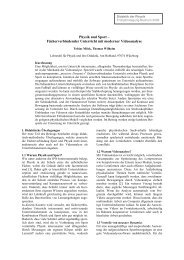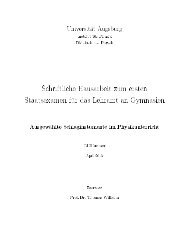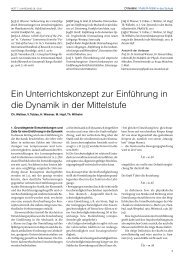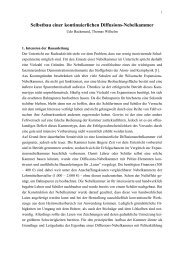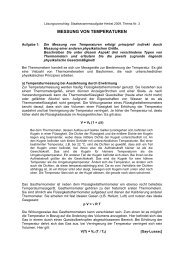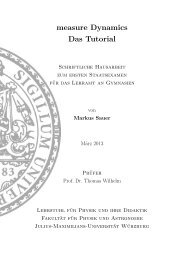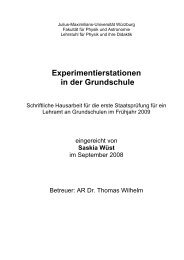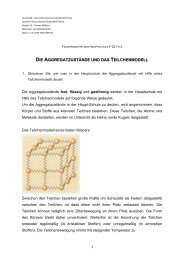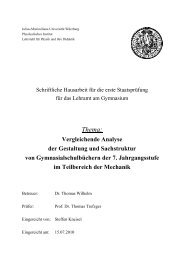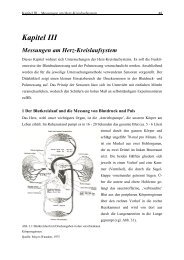Konzeption und Evaluation eines Kinematik/Dynamik-Lehrgangs zur ...
Konzeption und Evaluation eines Kinematik/Dynamik-Lehrgangs zur ...
Konzeption und Evaluation eines Kinematik/Dynamik-Lehrgangs zur ...
Erfolgreiche ePaper selbst erstellen
Machen Sie aus Ihren PDF Publikationen ein blätterbares Flipbook mit unserer einzigartigen Google optimierten e-Paper Software.
9 Abstract<br />
Even after the traditional mechanics instruction in the senior classes, many students do not have any<br />
adequate physical conceptions of the physical terms and definitions used, as well as of their coherencies.<br />
This study therefore commences with a presentation of general aspects of students’ conceptions<br />
(chapter 2.1) as well as precise students’ conceptions on mechanics (chapter 2.2) and relevant<br />
teachers’ conceptions (chapter 2.3). An objective of this study was to develop an overall concept for<br />
modified kinematics and dynamics instruction of motions in one and two dimensions in grade 11 of<br />
grammar school, aiming at helping as many students as possible to clear as many misconceptions on<br />
mechanics as possible. In order to achieve this goal, computer-aided experiments and the visualisation<br />
of physical quantities with dynamic-iconic representations (see chapter 3.2) were used, among<br />
other things, thus enabling new elementarizations as well as new teaching strategies (see chapter 9.2<br />
or chapter 5). In order to have good chances that this concept reaches the school everyday life, it<br />
was conceived curriculum-conformal to the Bavarian curriculum.<br />
The first goal of the summative evaluation was to determine to what extent the entire teaching concept<br />
can be implemented by different teachers, and how they assess said concept (see chapter 9.4 or<br />
chapter 6.3). Subsequently, an important objective was to ascertain, by means of tests, to which<br />
extent the students’ conceptions had changed (pre-/post-testing design), and to compare these<br />
changes with conventionally taught classes (treatment-/control-group design) (conventional classes:<br />
chapter 9.1; comparison: chapter 9.5; chapters 6.4 + 6.5). For that purpose, already existing paperpencil-tests<br />
were mainly used, as a new development of tests would not have been possible in the<br />
course of the study. These tests have various shortcomings, so several tests were used at the same<br />
time, complementing each other.<br />
Graphic modelling in combination with animations is part of this teaching concept. Additionally, an<br />
own intervention study was carried out in this context (see chapter 9.3 and chapter 4).<br />
9.1 Test results on students’ conceptions in conventionally taught classes<br />
In the tests carried out in the course of this study it turned out – as expected – that also after the traditional<br />
mechanics instruction in senior classes of grammar school (in Bavaria), a large proportion<br />
of students still give answers to qualitative problems according to the common students’ conceptions<br />
regarding the concept “acceleration” and the concept “force”, and not according to the physical<br />
conception (chapters 6.4 to 6.6). It was furthermore demonstrated that the kind of conception<br />
used depends on the context as well as on the type of problem, the wording of the problem, the type<br />
of motion, and even from the direction of motion.<br />
Even students at the beginning of 11 th grade solve 89 % of problems, in which the adequate timevelocity<br />
graph is to be matched with described motions in one dimension, correctly (number of students<br />
n = 373). Thus it is to question whether an intensive interpretation of velocity graphs in the<br />
context of motions in one dimension makes sense (chapter 6.4.2.2). If the corresponding time-<br />
acceleration graph is to be matched with described motions in one dimension, however, the situa-<br />
261




